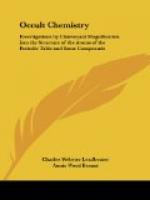The diagrams are not drawn to scale, as such drawing would be impossible; the dot representing the atom is enormously too large compared with the enclosures, which are absurdly too small; a scale drawing would mean an almost invisible dot on a sheet of many yards square.
The use of the words “positive” and “negative” needs to be guarded by the following paragraphs from the article on “Chemistry” in the Encyclopaedia Britannica. We use the words in their ordinary text-book meaning, and have not, so far, detected any characteristics whereby an element can be declared, at sight, to be either positive or negative:—
“When binary compounds, or compounds of two elements, are decomposed by an electric current, the two elements make their appearance at opposite poles. These elements which are disengaged at the negative pole are termed electro-positive or positive or basylous elements, while those disengaged at the positive pole are termed electro-negative or negative or chlorous elements. But the difference between these two classes of elements is one of degree only, and they gradually merge into each other; moreover the electric relations of elements are not absolute, but vary according to the state of combination in which they exist, so that it is just as impossible to divide the elements into two classes according to this property as it is to separate them into two distinct classes of metals and non-metals.”
We follow here the grouping according to external forms, and the student should compare it with the groups marked in the lemniscate arrangement shown in Article II (p. 377, properly p. 437, February), reading the group by the disks that fall below each other; thus the first group is H, Cl, Br, I (hydrogen, chlorine, bromine, iodine) and a blank for an undiscovered element. The elements grow denser in descending order; thus hydrogen is an invisible gas; chlorine a denser gas visible by its colour; bromine is a liquid; iodine is a solid—all, of course, when temperature and pressure are normal. By the lowering of temperature




